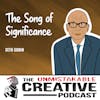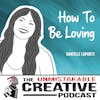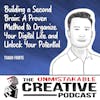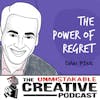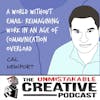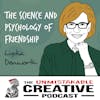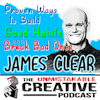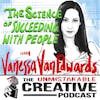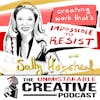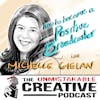Kevin Bethune | Lessons in Strategic Innovation from an Air Jordan Designer
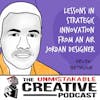
Kevin Bethune provides an incredible perspective on design and how it can be strategically leveraged to cultivate innovation.
Kevin Bethune began as an Engineer at Westinghouse and then moved on to work with Nike where he designed Air Jordans. Kevin provides an incredible perspective on design and how it can be strategically leveraged to cultivate innovation.
Subscribe for ad-free interviews and bonus episodes https://plus.acast.com/s/the-unmistakable-creative-podcast.
Hosted on Acast. See acast.com/privacy for more information.
Srini Rao
Kevin welcome to the unmistakable creative thanks so much for taking the time to join us
Kevin Bethune
Thank you for having me.
Srini Rao
It is my absolute pleasure to have you here. So I found out about your work by way of your publicist. You have a new book out called Reimagining Design, Unlocking Strategic Innovation. But what really got my attention about your story was the fact that you designed Air Jordans. And when I saw that, I was like, hell, yes, I want to talk to Kevin because Air Jordans are definitely unmistakable. But before we get into all of that, having read the book, I wanted to start by asking you, where in the world did you grow up and how did that end up impacting the choices that you've made with your life?
Kevin Bethune
Hehehe
Srini Rao
your career.
Kevin Bethune
Yeah, no, thank you. I was born in Newburgh, New York, but I spent the majority of my childhood in the downriver Detroit metropolitan area. And as you can imagine, most of.
Most of my neighbors, the community at large, worked for primarily the big automotive brands, American brands in Detroit, Chrysler, Ford, GM, kind of thing. And I think what was celebrated around me was sort of the expectation that you'd probably worked for one of the big automotive brands at some point, and you were likely gonna be either an engineer or a business person for those brands.
Srini Rao
Mm-hmm.
Srini Rao
So one of the things that you talk about in the book is that you actually were kind of upper middle class kids surrounded by people who weren't. And you allude to the fact that your parents wanted to make sure that you maintained awareness of that. How did they go about doing that?
Kevin Bethune
You know, I think living in predominantly white middle-class neighborhoods in that area
And then also like just reckoning with like what was being taught in the classroom. The notion of like, you know, being a black person, you definitely felt like the other many times. And usually the history that was covered around black history was like reserved to like history month or like maybe a single page out of the social studies book. So my parents originally coming from the South and you know, being like definitely
to generations that came before them, they definitely had an awareness of like, just ensuring that knowledge of self was promoted in the household. And so we were always like on weekends, you know, going to museums, engaging in extracurricular things that exposed us kids to more than what, you know, we were exposed to in our everyday sort of walk through the school systems and just celebration of black history, you know, reading where we come from, all that was just a part
of the, I guess, zeitgeist in the family home.
Srini Rao
Yeah. What did they teach you about what it means to be black in America? Because I had a number of African-American guests, some of who served time in prison, others who've built incredible companies. And the degree to which they are taught things is really diverse. It's, it's kind of mind blowing. Some of them said they learned absolutely nothing. And some of them, you know, are the things we hear, like you're taught to fear the police. You know, I'm curious, like what did your parents teach you about what the color of your skin meant?
Kevin Bethune
You know, I think in general they just encourage us to be proud of who we are. And I think that was like...
celebrated in terms of like the stories of like the family of which we came from. You know, on my mom's side, she was one of 10 kids and you know her father owned land at a time where, you know, that was like absurdly sort of heard of, unheard of, and this is the panhandle of Florida at the time. He actually owned land and, you know, it was
Kevin Bethune
time period, but the level of harassment that they endured because they held land. My mom would tell it like they had guns literally propped up every nook and cranny of the house in case something were to sort of pop off. In the book I sort of tell the story of how my mom...
was like not even two, their house got burned down from white supremacist sort of actions in the area. So these stories were like vividly told from my immediate family and generations of family that came before. And so I think that's where the rooting took place.
Srini Rao
Well, so when most of us think of Detroit, I think that what we see is basically what we see on TV. Like, I think my primary association with Michigan or Detroit is Flint because of all the media that I've been exposed to. What misperceptions do you think that media creates about the communities in that area?
Kevin Bethune
Mm.
Kevin Bethune
Um, you know, I definitely, I think the natural inclination is to talk about like...
you know, the industry sort of penetration and footprint on the culture of that area. And then, as you said, like Flint, like we see stories of how when industries leave, supply chains outsource, and these kind of things where, you know, communities are left reeling from loss of jobs, loss of infrastructure, loss of support. So that, I mean, that's real, those systemic issues are real and continuing to plague those areas. But at the same time,
that area and in particular the black community across that area just the level of creativity, ingenuity, entrepreneurship. I think oftentimes those stories don't get told.
Srini Rao
Yeah, you know, I remember we had Sean Dove, who was the founder of the campaign for black male achievement here. And one of the things that he had told me was he said he realized that he wouldn't see the end of racism in his lifetime. And that, you know, as disappointing as it was, he came to that conclusion. And I remember telling him, like, Sean, don't you think it's crazy that we're in 2022 and we're having a conversation about something that we thought we got passed almost 60 years ago. And it's still so prevalent.
Kevin Bethune
Hmm.
Srini Rao
What do you make of that? Like, how did we get past this? Because you and I are both not white. And I remember when all the George Floyd stuff was going on, you know, I had two white roommates and one of them started reading, you know, either white fragility of one of those books. And he's just like, yeah, I guess I never thought about my skin color. I was like, yeah, that's because in America, if you're white, it's like being, you know, water to a fish, you don't think about it. But I mean, I was a brown kid who grew up in a small Texas town. So I was very aware of my skin color.
Kevin Bethune
Mm-hmm.
Kevin Bethune
Yes. Yeah, you know, I think in any space that we navigate and I guess I'll first say that every...
every overt thing that we might see in the news, whether it's police brutality in the black community or hate crimes against Asian American Pacific Islanders, like the overt stuff that jars us definitely still connects to the covert racism and ignorance that we experience and feel, whether it's consciously or subconsciously in places where we spend a lot of time. So whether it's the workplace or navigating academic institutes,
institutions in everything that we navigate is the way it is by design. And I think, you know, I think the world sort of is waking up still, you know, and unfortunately took Black Lives being murdered in the streets via the summer of George Floyd and whatnot for people to become aware. But many of the spaces have been designed by folks who make up, you know, the, I would say very few folks with a lot of power and privilege.
privilege that profess to be the majority, profess to be sort of the gold standard and profess to uphold some sense of meritocracy. And you know, I think a lot of those biases, a lot of that ignorance, racism is still very much hardwired in everything that we navigate today. So yes, it will take a long time for all that to get unwound and unpacked.
Srini Rao
So how do you begin to unwind and unpack all of that? I mean, and where does it start? Does it start at the individual level, community level? Because clearly to your point, I often think politicians make decisions that don't affect them at all. They're making decisions on behalf of people's lives when they're not affected by those decisions. Like the person I always go back to was like, Steve Mnuchin is making treasury policy for poor people and he has a guy, he was a guy who's worth $100 million.
Kevin Bethune
That's right.
Kevin Bethune
Yeah, I think it takes, at every level honestly, of just taking, shining a light on the truth. And...
You know, how do we do that? I think human beings and communities at large, they're motivated by stories. Movements are started by sheer fact of really elevating a story that galvanizes people, that inspires people, that bubbles up the convictions inside of us when we hear a story around the truth. And in many ways, I think in recent decades, the truth has been hidden.
Oh, you know, speaking for the black community, if rights were bestowed on a certain year, the right to vote, the right to do certain things, our civil rights were officially granted to us. But...
If the stories around how deeply wired our institutions have been informed by racism and ignorance and bias Like if that truth has been withheld for so long and now we're starting to see stories actually you know unearthing the truth unearthing the data unearthing the threads of systemic imbalance and how that has informed everything from redlining to um, the guiding principles that guide artificial intelligence to
now start to share these stories, we can start to you know visualize the data if you will and put a glittering light on those imbalances. So that's where I find hope that you know the light is finally penetrating in some ways.
Srini Rao
Well, I want to come back to that. We'll talk about diversity inclusion in the role it plays in design a bit later so What did your parents encourage you to do as far as you know? Career advice or anything like that. Did they give you any specific advice about making your way in the world?
Kevin Bethune
You know, I think they definitely observed us kids and what we were sort of into naturally. And for me, drawing always had a place.
That was how I sort of like understood and observed the world and expressed the world in terms of how I understood it working. But in terms of like the translation between that and a career path, it wasn't, it wasn't necessarily understood or fully embodied in terms of how my family may have viewed that. They, of course, they encouraged me. They applauded my attempts to exercise creative volition. But again, their worldview didn't necessarily comprehend or understand design or
I think the natural inclination was to think about engineering as a potential career path because they saw that I was sort of decent at science and mathematics as well as the drawing and all those things could have some viability on an engineering career path. So that was sort of the thing. And they always ask me, like, what do you want to do? And I said, I think at one point, oh yeah, engineering I think is the path for me. But I didn't really fully understand.
Srini Rao
Yeah.
Kevin Bethune
what that meant. And I did remember anecdotes that spoke to creativity but I didn't know how to articulate them as design or innovation.
Srini Rao
Yeah, I can relate. I mean, I always jokingly say the Indian parent motivational speech is what kind of doctor, lawyer, engineer do you want to be? So how in the world do you go from studying engineering at Notre Dame to designing for Nike? And one other question on top of that, what would you tell parents listening to this about encouraging creative self-expression in their kids?
Kevin Bethune
Yeah.
Kevin Bethune
I think what I would tell parents is that based on how the world is moving, how...
disciplines are converging, no matter whether it's from a business, science, technology, or creative angle, the future requires a commingling of all these different disciplines. And what was maybe not deemed a credible or viable career path before, the world has absolutely changed to embrace the power of creativity. So any one of those disciplines, like there are viable careers that you should seriously have your kids look into based on their curiosities.
in that respect.
Srini Rao
So speaking of curiosity, how in the world does somebody who studies engineering become somebody who designs shoes?
Kevin Bethune
Hahaha
Kevin Bethune
You know, I think hindsight being 20, I think when I was an engineer, I love that chapter, honestly, you know, it was the chance to apply science, math, ingenuity, experimentation, as well as, you know, visualizing and drawing, of course. But but really cutting my teeth on product in that world. But I can say that within most engineering paths, sometimes like when you're a good engineer, you have a particular subject matter expertise.
keep exercising that capability over and over again. And you might feel a limitation on your agency for where your career can ultimately go. And I started to feel that saturation. I felt that plateauing happening. But the curious me wanted to know like, how can I have more license or influence? Like how can I help influence the bigger picture around what the company's doing beyond my technical background? So fast forward,
that curiosity made me realize that I actually lacked a tremendous amount of just business acumen in general to be a part of a strategic conversation. And so that curiosity led to business school. Business school allowed me two years to sort of take a step back and look at the career with holistic eyes. And I just remembered that creative itch from youth that was scratching. And I told myself, you know what, I could go back to an engineering organization or I could try to find an organization that embodied not only strategy and technology
of faculties as well and not knowing what I would do with that but that was where the heartstrings were tugging and thankfully companies like Nike and Apple of course rose to the top of the list for that reason and Nike afforded me a path in. So I started as a business planner but as you remember I was a product person from my engineering background and I just started networking with people while being mindful to the business planning job.
Srini Rao
down.
Kevin Bethune
those product folks and sure enough after 18 months
Coffee Chats ended up becoming stretch assignments where I was like helping the product organizations sort of as a side hustle for free, just to show that I was passionate about what they were doing. And then that led to a formalized job within the footwear product engine at Ikea. And that's when I started meeting real professional designers for the first time. And I became just immensely curious about what they were working on. And that networking with creatives turned into more side hustles. And so the Jordan brand,
Srini Rao
Mm-hmm.
Kevin Bethune
to take a bet on me. They had too many briefs, not enough designers to take them on. And so the footwear design director at the time, a gentleman by the name of Duane Edwards, who's a friend and mentor to this day, he said, if you meet me in the mornings, early morning, like let's meet here at six at my office, we'll commiserate on these briefs, I'll guide you, and then we'll go do our day jobs, and then you go work on my assignments at night and come back the next morning. So we did that for a year.
and launched two shoes in the marketplace. That did really well for the Jordan brand that year and that started opening up more doors.
Srini Rao
Yeah. Why do you think more people are not like that when it comes to seeking opportunities in their career? They kind of, you know, stick to their job. I think back to the movie Son of a Woman, who when Al Pacino looks at Chris O'Donnell and says, yeah, we're going to New York. And he's like, I can't go to New York. And he says, what are you some kind of chicken shit who sticks to job description only?
Kevin Bethune
Yeah, no, and I definitely felt that too. You know, there was.
for any curiosity and desire to connect the dots or reach across the aisle to a different department, there were definitely like nine conversations for every 10 around like, you shouldn't be doing that because, that's not your title or that's not your job or what are you doing? But there was always like one out of 10 conversations that were encouraged by that curiosity and they just gave me some inspiration or some wisdom in terms of how to navigate. So I'm always thankful for that. But I think it goes back to like,
around like knowledge of self, the world's gonna tell you no, they don't see that for you. And I think, you know, having that seed planted early from my parents just kept me basically resisting that sort of inclination from other people to say, well, you may say it's not for me or you don't see it, but like why not me? I'm gonna I'm gonna go lean into this curiosity.
Srini Rao
Well, let's talk specifically about Air Jordan as a brand, because I remember in our email exchange, I told you that those were the shoes that I could never afford, and I very distinctly remember all the ones I couldn't afford, and kids coming to school with baby Jordans as key chains. I'm not a sneakerhead, but Jordans, Air Jordans have always stayed sort of in the zeitgeist as this iconic shoe.
Kevin Bethune
It's wild.
Srini Rao
And I remember when I had my first internship, even though I don't play basketball, I haven't set foot on a basketball court in years. I did that summer. First thing I did when I got a paycheck is I went down to the Nike outlet. I bought a pair of Air Jordans for no good reason. And it was mainly to satisfy that childhood desire. And so what is it about something like the Jordan brand? Like, why is it that it has the impact on culture that it does? You know, why is it that it has the staying power that does what enables that?
Kevin Bethune
Ha ha.
Kevin Bethune
Yeah.
You know, I definitely, my mind was blown when I got to know the Jordan team and it was invited. They welcomed me with open arms because I think they realized, not just Duane, but the other team members, they realized that I was willing to do anything and everything to push ideas forward and respect the Jordan way of how to do things. And I can say, you know, as a former insider within Nike, like when I navigated those Jordan meetings,
They did things differently. I think the fact that Michael Jordan, who was the pinnacle inspiration, and still very much an inspiration for the reasons of how he performed on and off the court, like his competitive mentality, his drive for excellence, like all those things, like you felt that in the Jordan brand as a team, as an organization.
And he wasn't just a black pinnacle athlete that was basically aligning himself to whatever Nike was going to give him in terms of game shoes and the franchise that was Jordan Brand. He had expectations of the brand. The fact that it would be guided by primarily black leadership. The team had to be of the culture.
Srini Rao
Wow.
Kevin Bethune
Michael Jordan's sort of wishes and requirements to be in relationship with Nike. So you felt the culture when you navigated the Jordan brand team and you know they were a small, they are very much a small scrappy team compared to perhaps other larger Nike categories and that team knows how to deal a lot with less and they make stuff happen because they're very proximate to their audience in a good ways I think.
Srini Rao
Yeah.
Srini Rao
Well, I mean, it sounds a lot like the industrial design team at Apple from what I've read about that team. Because I remember I've seen a handful of documentaries about this. One was with Sunny Vaquero, another was with Tinker Hatfield. I think there was a sneakerhead documentary on Netflix. And the level of just obsessiveness and detail that goes into this was mind boggling to me. And I think the thing that I remember very distinctly was when LeBron was negotiating with Adidas and Nike. And they said that, you know, Adidas wouldn't offer more.
Kevin Bethune
Mm-hmm.
Srini Rao
And so he went with Nike and that shoe apparently ended up making a fortune in the first year They made that money back a hundred times over
Kevin Bethune
Yep, not surprising.
Srini Rao
Yeah. So the thing is like, you know, to me, Jordans were this sort of, you know, thing that I knew I could never afford. My parents couldn't afford to buy them. And I remember you telling me the same thing that you didn't have your first pair until you worked at Nike. And yet there's a sort of interesting contrast. We live in this world of social media where everybody's lives are on public display. We're all showing off.
And so how do you balance that with the sort of value that, hey, this is not about, you know, showing off or how much money a kid has, but ultimately the value of performance? Does that make sense? I realize it's kind of a weird nebulous question.
Kevin Bethune
Uh, you know, I definitely am sort of like, sometimes revolted by like, hype-beast culture, where it's like, you know, just to show off that you have the new or better thing. It isn't necessarily, um...
Srini Rao
No.
Kevin Bethune
It doesn't speak to like what humans and communities need. If anything, it's just kind of showing off waste. I guess it's sort of the impression I get with a lot of stuff that I find celebrated on social media. But at the same time, you know, as a product person, as a designer, I love a good product. I love to engage.
let's say if we're talking sneakers, like I'll engage a pair if I fall in love with the story of how that shoe was conceived or you know the story and brand and celebrity around like the pinnacle athlete that I was modeled after. Like if there's a story that makes me remember like the things that inspired me as a kid, the things I find fascinating, then I'll latch onto that story, I'll latch onto the product and I'll keep that product for a while, you know, and celebrate.
it every time I wear it and feel good, it makes me feel good. That I'm for. Just splashing extravagance for the sake of it. I'm not necessarily for that.
Srini Rao
Yeah, it's like those idiots at my junior high who showed up with baby Jordan's keychains, which to this day, I still can't forget. Well, what actually goes into the process of this? Like, what does this design process look like? Because I think that'll make a perfect setup to talking about the book. And how do we apply these principles in our own work?
Kevin Bethune
Hahaha, yeah.
Kevin Bethune
Yeah, I think if we use shoes as an example, I mean, there usually is some cloud of opportunities surrounding the business's appetite to want to conceive of a new shoe. Perhaps there's a little bit of a white space sort of carved in the market. So the industry landscape might...
provide good timing to introduce a new product. There could be a set of potential athlete needs or things, value criteria that a particular athlete may prioritize or value more than anything else, and we need to elevate that, tap into that. There also could be trends that are sort of informing spaces and curiosities. Trends could be the full gamut of trend from tech trends, material innovation,
colors of the season that folks are interested in. And then we might go find like examples, like perhaps if I'm working on a shoe, there might be a color or material inspiration over in high fashion or in Swiss watches, I'm just making it up. But like, I may like post those things on my mood board to inspire the next step. And then I'm gonna go on a creative journey of, and perhaps there's a brief that,
Kevin Bethune
using to articulate the opportunity a bit more clearly for me as the designer. But I'm going to go on a path of additional discovery. So maybe I'm going to go talk to more athletes. I'm going to go find extreme athletes, whether they're laggards or early adopters, and get more latent substance around unmet needs and motivations that they're thinking about. Then I'm going to go on a terror ideation. I'm going to diverge and create multiple sketches if not.
tens or hundreds of sketches, little thumbnails to get to some threads of potential opportunity in terms of how I'm rationalizing the opportunity through a design lens. And then at some point I'm gonna turn the corner and converge on a couple of bits that I wanna propose to the team. And if I rewind myself and put myself back in the Jordan Brand team, I'm also, it's not just me sort of pushing that idea forward. I also have to lockstep in
the developer on the team who's sort of looking at the engineering realities, looking downstream to what the factories have to deal with. I also have to sync and align with the product marketer that's on the team and ensure that you know they I gotta understand how they foresee the shoe sitting on the shoe shelf, how that's being prioritized, how that's being priced, how that's being merchandised, like all those considerations go into whether a shoe
dates and decision making steps until it actually is commercialized on the store shelf. So that ebb and flow of discovery, that ebb and flow of divergent ideation leading to convergent ideation to something that people get excited about, that's the typical process for me.
Srini Rao
now.
Well, one of the things that you say in the book is that we have to ask ourselves a couple of basic questions before we dive Into this area continues to amaze me how often these basic questions are overlooked or taken for granted when investigating a business's value proposition Who is our audience? Who are we serving who's serving them who are all the primary constituents and stakeholders? What do they value and I think that really struck me because I see this so often particularly with digital products where people create something and they wonder why nobody wants to buy it and you know it took me a long time to
really understand that okay wait a minute if you want somebody to spend money on something it actually has to solve some sort of problem for them.
Kevin Bethune
Yeah, no, absolutely. You know, oftentimes there's different motivations around an opportunity and...
you know, I'll be extreme in terms of this characterization, but with, especially with digitization and sort of the rush, the gold rush to want to launch the next app and, and think that that's going to, you know, garner us the outsized returns and make our investors happy. But if we're sort of coding in a vacuum against some preconceived hypothesis, and we haven't talked to anyone, or we don't have a good sense of like who our
the product hypothesis that we have on the table, we're gonna end up having a rude awakening when we try to launch and we try to scale and we don't achieve that resonance. Or even worse, if we're part of a team and maybe that team includes investors and the like that are so fed into the hypothesis that they're willing to just throw money and burn money until they feel that they're gonna get an outcome and that outcome never materializes.
seeing stories like that rush to epic scales and there's all of a sudden that deflation. There actually could be harm as a part of that story arc as well if we're not careful.
Srini Rao
Mm-hmm. Yeah. So...
One of the other things that you talk about is this idea of first principles. And you say, usually when we think about innovation against a given industry sector, there's a tendency for people to subconsciously align themselves to the present consensus of how an industry is supposed to run or behave. Instead, I would encourage us to evoke a conversation that focuses on the first principles of the industry in question. Let's unpack that a bit more, because I think first principles, unless you've sat around reading Ray Dalio books
a lot of time reading about Elon Musk, they can be somewhat nebulous. But let's just talk about it in terms of content creators. Like take the podcast, for example, I think when I looked at first principles, it's like, what is the podcast made of? Ultimately, it's not audio, it's words. And words can be repackaged and repurposed in all sorts of ways. Like I started to really kind of see this through a very different lens, but how do you start to develop a capacity for first principles thinking?
Kevin Bethune
Uh, honestly, it's...
breaking down the fundamental piece parts, honestly. I think in my experience, like I'll step into any new business opportunity and I definitely feel that pressure of market convention and sort of like, this is how things have been done. And you need to align to that. You need to align to like what's gonna move the needle in my particular like space, respect the metrics and the KPIs that we need to hit. If we're talking about a new product, it still has to meet these KPIs and get investors back their money. Like these are the pressures
that we feel and then also add computation to the mix. And the speed of digital, the speed of change that's expected only seems to be increasing. So in many ways I found that speed is often an invisible authority in the room that inhibits teams or individuals to be able to raise their hand and start asking some of those questions. Like why does it have to be this way? Or why do we have to like placate to the norms always? Like can we break convention?
So all I'm encouraging is like, I think when we have design at the table in these situations, like we can actually revisit the piece parts that make the industry sort of tick in our own company, like how that ticks. And, you know, there are some canvases that we could use as well as other frameworks to be able to dismantle the piece parts, really expose the assumptions that are at play behind any supply chain or behind any business model.
and get that on the wall and allow ourselves the opportunity or the mind space just to start asking some questions. Like, why does this input assumption always have to hold true? I think in the book I use the example of, like anytime you're making new footwear, there's really expensive molds that are required. And think about all the size runs around a shoe from size seven all the way up to 13 to 14. Think about all the expensive steel molds that are required to have anything
Kevin Bethune
in the footwear space. But why do we have to just always accept that cost assumption as a foundational first principle? Like why can't we introduce different methods of make to disrupt that input assumption to open up opportunities for, whether it's customization or personalization? So I talk about the example of additive manufacturing as an example where you could actually disrupt the input cost associated with steel molds. Like why can't we do enough?
type of mold or print footwear parts in the first place from a 3D printer and have that be part of the product. This is some of the disruption that we're already starting to see in the space of footwear but I think it applies true for any business model opportunity.
Srini Rao
Yeah. Well, speaking of canvases that we can use, you have this four quadrant model where you talk about horizontal and vertical growth and existing revenue and new revenue. Can you expand on that and explain it to us?
Kevin Bethune
Sure. So at the end of the day, and this is coming from my professional experiences as a product person and as a designer, is that ultimately, whether you call it invention, innovation, or you get excited around any idea, a business is always gonna translate that into growth. And growth is a...
is a fully loaded word in that it's important for us to unpack the context around what type of growth that we're after. So many organizations that I work with to this day, they might be a startup that's trying to build something from Greenfield, or it might be a large corporate that already has an existing franchise that they need to sustain and cultivate. At the same time, they're also reckoning with disruption where the market is eroding what has worked for them in past decades.
different in that there's a lot of different competitive threats to the core franchise. So they might need to think about ways to proactively manage the maturation of their core franchise and eventually replace it with another viable value proposition that fosters high growth and high margin and those kind of things. So they need to think about proactively sunsetting their stuff for new stuff eventually.
Kevin Bethune
what you're working on, context is so important. So that two by two that you mentioned, like the left side of that two by two is giving recognition to the...
it's giving recognition to the core platform that's already there. So you might need to like tweak the existing franchise and fix things that are broken. We call that re-engineering. But sometimes you might need to like build from zero to one a new capability that will eventually replace the existing core franchise. So that you could say, you know, we're gonna proactively make a competitive attacker ourselves, a digital attacker for example,
Kevin Bethune
the incumbent core franchise. So that's like a vertical element, but again, it's all about addressing the core franchise. But if we move to the right of the two by two, there might be ways to extend the benefits of the core franchise and like reimagine customer journeys, customer interfaces and experiences. So that gets into the re-imagining territory. But if we wanna build like, let's say a new startup from Greenfield around a given unmet need in the marketplace,
build a vertical business from zero to one and it's going to offer you know perhaps differentiated experiences beyond what the core business is doing right now. So that's something that we have to build from Greenfield and bring in the right capabilities and treat it like a startup. So that's how I dimensionalize growth in that respect.
Srini Rao
So one other framework you talk about is the steep framework. Can you explain what that is and how we apply that?
Kevin Bethune
Yeah, you know, as we sort of looked at the future time horizon, I sort of used the visual metaphor of a looking glass. We have to think about like how trends are inspiring and informing the art of what's possible and even plausible. Now, when I mentioned trend, like I'm even guilty of it in that my mind might latch on to tech trends like Moore's law and...
power of computation and battery size getting better, chips getting smaller and more capable and all the things that we typically hear about with regard to tech trends. But what the steep acronym encourages us to start to think about is to really explore the full gamut, the full diversity, the full categorization of potential trends that are informing a given space. And so steep is just a helpful rubric
or holistically and widen their aperture. So Steve refers to the, let's actually go curate and collect the sociological, the technological, the economic, the environmental, the policy slash regulatory, and even energy related trends that are informing a given space. And usually when we write the acronyms, sometimes we put a plus sign because there might be other categories of trend that we need to curate. Like in the space of healthcare, there might be delivery model trends
that we need to curate and collect as well. So you might add an additional category around delivery trends for healthcare. But it's all in the spirit of just, hey, starting point, it's a rubric, let's widen the aperture using it.
Srini Rao
No. One other thing that really struck me that you said, you said that we need to evoke a central story of a person's experience that represents a new idea. What story are we telling? Is it an interaction between human beings? Is it an interaction between a human and a machine? Is it a machine-to-machine interaction that emulates some desired trait of interactive behavior? What story we're telling and what medium will be necessary to fully embody that story?
How do you apply that? Like, let's go back to shoes. Like, when you look at this through the lens of designing shoes, how does that play out?
Kevin Bethune
Yeah, you know, I think ultimately the consumer wants to be a part of a story in terms of why they would be open to considering purchasing a new product, a new pair of kicks. But I think what I encourage is that we think about how we show up for that person that we're designing for. Not in terms of us trying to get Vince to buy all the time.
Click.
No, how do we actually show up in their journey and in their circumstances? So like, does that new pair of kicks actually provide a new level of utility that they hadn't had before? That's gonna like satiate a desire to perform. So utility becomes a key ingredient of the story of like, how do we show up and how do we unlock utility in their journey on their terms? And then secondly, we know that customer is always
messages from every brand under the sun. So like how can you know in our story how can we actually parse through the noise and convince that person that we're the most authentic bet to decide upon. Like if we parse information that's going to actually elevate their confidence to be able to like embrace that new utility that we're recommending to them. And then lastly if we show up in the right way you know with our story that Melton says they're you know
an emerging story. And if we show up at the right inflection point when they need us the most, like we'll establish an emotional bond. Like we were there when it mattered, right? And so that emotional bond is going to make that person want to consider us the next time they have a need. And then that's how loyalty, I think, is established when it comes to certain brands, especially in footwear.
Srini Rao
Yeah, I mean, I guess in a lot of ways, if I were to summarize it, it's like, you know, be like Mike is the story a kid gets to tell themselves when they put on a pair of Nikes. I mean, that was kind of I remember when I got to go to a basketball game. When I was a kid, my mom asked me, she had a doctor that she worked for who had season tickets to the Rockets. And keep in mind, this was like during the last dance era when the Bulls were basically Jordan Pippen, pretty much everybody and like any kid, I was like, I want to see the Bulls.
Kevin Bethune
Heh heh.
Kevin Bethune
Mm-hmm.
Kevin Bethune
Mm-hmm. Yep, yep, totally. I mean, it's like you see performance on display, you get a sense of that emerging story that, you know, that's someone that worked harder than anyone in the gym, on the court, and you're seeing like the manifestation in that moment, and yet those moments never leave you. And of course, it's gonna make you wanna go buy the next pair of shoes that allow you to jump faster, you know, run farther, run faster, and be a part of that story too.
Srini Rao
Yeah, unfortunately, I'm Indian, I was, you know, not pre determined for athletic accomplishment. But you know, I was genetically, you know, screwed, you know, as we always joke, it's like, there's no way you know, no Indians have actually there is an Indian guy who made it to the NBA, surprisingly. So the documentary about him on Netflix came from some village in India. Yeah, it's called a billion to one. Yeah. So one of the things that
Kevin Bethune
Hahaha.
Kevin Bethune
Oh, I have to check that out.
Billion to one, okay.
Srini Rao
You also say is that brand is more than a logo or wordmark. Most innovations need a lot of affordances to get off the ground and branding offers a nice set of checks and balances for each element of new ecology that we're bringing into the marketplace. It can serve as a filter of sorts. We can check each element for authenticity behind the overarching promise. Remember the three C's, commerce, content, and community. These and their interconnections, especially important in our hyper-connected world. Brand helps shape the mission, vision, and emotional characteristics of each Fordance with our growing ecology.
feeling hierarchy and visual language of our content strategy, brand needs to excite a community by giving clear messages that its members can identify with and rally around based on the demonstrated promise to satiate their needs. And I love that because I think that branding is one of those things that is so misunderstood and so nebulous and whenever I think about personal branding I think about something that Oprah told to Tom Brady when she was talking about some young girl who was saying I'm building my personal brand and she's like honey you don't have a brand you haven't
any work.
Kevin Bethune
Oh boy. Yeah, you know, it's... Sorry.
Srini Rao
And so yeah, where do we start with this? Like, because the thing is, I think that too often people think brand is just as simple as putting up a website and saying, okay, you know, I have a personal brand now.
Kevin Bethune
Hmm. Yeah, you know, I think I think there sort of needs to be
a promise at the end of the day and can we back up that promise, whether you're an individual cultivating a personal brand or a company trying to introduce their brand to the world, the promise needs to have substance behind it. There needs to be confidence and credible trails of evidence that speak to, okay, you can actually communicate that promise. Any interaction that your existing customers have or new customers that you're trying to
engage, like there should be consistency in that promise as those interactions happen. But again if you haven't done any work it's not as simple as standing up a website and calling it a brand.
If anything, you know, it may make sense to like just get your at-bats, whether you're an individual starting your career and you have at-bats and you start to learn what you're known for and the mark that you make on the world. Same is true for companies. Like, what type of mark are you making in the landscape? And do you have enough to make a claim that you can articulate a promise against?
Srini Rao
Mm-hmm. Yeah.
Let's talk specifically about collaboration and breadth and depth because the thing that I'm always baffled by is when I see creative people in particular, especially because we now have this whole solo entrepreneurship idea, this creator economy thing, they try to go it alone. And I realized after a certain point that what Scott Belsky said in one of his books, no creative idea can thrive on the energy of one person or not even not even thrive, survive on the energy of one person.
Kevin Bethune
Hmm.
Srini Rao
like a book, right? There's a million people behind the scenes who make the accomplishments of the author possible.
Kevin Bethune
Totally. Yeah, there's a huge difference.
Srini Rao
So how do breadth and depth play a role in all of this?
Kevin Bethune
No, you're right and Scott is right. You know, there's a huge difference between an idea from a singular individual.
and commercializing an innovation. And I think based on what the future requires, like we definitely, for any idea to become a viable innovation and become a viable business, like we have to think through the aspects of, of desirability, we've got to think through the aspects of like, can we actually make money from this idea and can it be a viable business concern moving forward? And there's, we need the right like collaboration and people to bring that forward. And then.
especially in the space of wrestling with digital technology in general, how easy or difficult is it to actually prototype and execute and implement and have our solution actually take footing in the market? How hard is it to do that? So how feasible is it? So I think when we think about breadth and depth, we have to bring in more actors beyond ourselves for any idea, whether it's publishing a book, designing a pair of kicks.
more people have to be involved. And Brett, what I'm really speaking to is the need for us to bring those different actors together on the table to communicate together on the imperatives that matter, to collaborate in terms of like, you know, connecting the right dots, generating the right ideas, prototyping and learning from the marketplace, and garnering strategic alignment. Like what are we gonna actually prioritize against a strategy, against that overarching brand promise
have on the table.
Kevin Bethune
And then the depth still speaks to the need for the experts around that table to still have the time in the breathing room to get away from the team, to go do the deep work that's required. Like you got to go let the engineer be the engineer and go code the best prototype. You got to get, let the designer, you know, sketch with craft the best value proposition of a shoe on, on whether it's 2D or, or 3D. Like go let them be the
designer, go let the anthropologist get in the field and come away with the insights that matter. Go have that business person derive multiple scenarios of business model in Excel and then come back with a substantial business model prototype. That's the breadth and depth that I think this future is requiring of us.
Srini Rao
Oh, wow.
Well, in the interest of time, I know we could talk about all the ideas in this book all day long. But there's one thing I wanted to come back to. And we're talking about diversity and inclusion in the workplace. And one of the things that you say here is that black Americans experience racism in the form of microaggressions, gatekeeping and passive aggressive manipulation that manifests in glass ceilings and exclusion.
Srini Rao
evolve, I believe these behaviors are actually very conscious based on the choice not to educate oneself about the threads of systemic racism in America and not recognize power and privilege in one's present position. So how do leaders develop the self-awareness to not be guided by their unconscious bias?
Kevin Bethune
Yeah, you know, I definitely am careful to say, like, I don't have the magic pill for all the litany of problems that pervades the workplace when it comes to, like...
developing the most inclusive environments that we could aspire to achieve. But what I do tell in the book is the story of my lived personal and professional experiences of black man navigating corporate America. I'm very careful to not speak for women. I'm very careful not to speak to non-binary or any other makeup of person. And we all represent layers of intersectionalities that make us human. So these are complex concerns,
experience leads me is really trying to characterize for readers this gradient between like what I find is what I find is
like a tendency to placate to gatekeeping behaviors that keep, you know, the status quo sort of upheld or keeps exclusionary practices going and keeping people out of the bigger priorities and opportunities. And then the other end of the spectrum is what I, I dimensionalize as servant leadership. And again, I unpack like servant leadership is not my term, right? Nor is gatekeeping.
But what I try to do is, at least from my experience, is unpack seven dimensions of what it means to be more of a servant leader than perhaps a gatekeeper. And on any given day, any one of us can find ourselves at different ends of the spectrum. So this is not to say that, again, I won't profess and say I've always been a servant leader. I've probably played into promoting comfort fit at certain times of my career. But in recent chapters, especially
Kevin Bethune
relevant innovation work to ensure that, you know, hyper-connected people that represent diverse facets of society, like, it's less about like having conversations that we used to have and where someone might say, oh, I'm interviewing this person, but I didn't think I could like, I didn't think I wanna invite that person to have a beer. I don't think that person is likable or fits our culture or fits, and it's like, what are we talking about when we're having those conversations? And knowing what we know today,
those conversations are actually very inappropriate. Instead, the servant leader's gonna have a conversation around like, I'm interviewing this person, I really wanna know how they're gonna really push us for the better, how they're gonna challenge our existing pedagogies and methodologies, how are they gonna really move us to connect with new demographics that we haven't been talking to correctly, how is that person gonna help reduce the blind spots and biases? We should go find that person that's gonna shape us
the better versus hiring someone that we're comfortable with or feel we can go have a beer with.
Srini Rao
Yeah. Wow. Well, I have enjoyed talking to you so much. I feel like this is one of those conversations that has left me with a lot of questions, which is always a good thing, because those are the kinds of conversations that force you to think. I have one final question for you, which is how we finish all of our interviews at the Unmistakable Creative. What do you think it is that makes somebody or something unmistakable?
Kevin Bethune
I think it's someone who's not afraid to lean into their own curiosity and actually develop their own unique set of experiments against what makes them tick and what excites them. I think if we allow ourselves to be who we are and go after the things that excite us, that make us curious, we're going to leave our own unique indelible mark. So that's what I would encourage.
Srini Rao
Amazing. Well, I can't thank you enough for taking the time to join us and share your story, your wisdom and insight with our listeners. Where can people find out more about you, your work, the book, and everything else you're up to?
Kevin Bethune
Sure, so all roads lead to my author website right now. People can go to Kevin Bethune, just my name, hyphen, reimaginingdesign.com. So all facets of what's going on with the book. And then my present design and innovation practice, Dreams Design and Life, just like it's spelled dreamsdesignandlife.com, gives you a sense of my business concerns. But I'm pretty easy to find on social media just under Kevin Bethune.
Srini Rao
amazing and for everybody listening we will wrap the show with that. Awesome.
Candid Conversations: Elevate Your Thinking with Masters of Their Craft
Dive into a realm of transformative conversations, where wisdom from trailblazers who've shattered norms is at your fingertips. Learn from best-selling authors who've decoded productivity, and thought leaders who've sculpted the landscape of personal and professional growth. Unearth the secrets of successful entrepreneurs, delve into the science of habits, and explore the art of charisma. Each conversation is a journey, brimming with unexpected insights and practical wisdom that will ignite you
